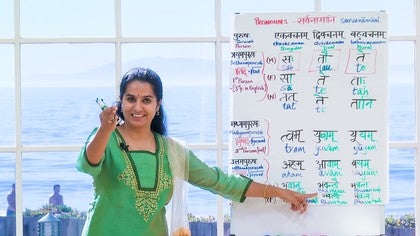Description
About This Video
Transcript
Read Full Transcript
Namaste and Swagatam dear friends, we have been looking at some vocabulary of Sanskrit, some words and one thing that became very evident is that when we are looking at Sanskrit nouns we have to take the gender into consideration. So all Sanskrit nouns are either masculine, feminine or neuter and that is the most important information that allows us to then use the word in the way we want to as the sentence builds. The next thing that we will look at are the pronouns and just like in English the pronoun is that word which is used to replace the noun. So when I say the man goes, when I use a pronoun it becomes he goes, the pronoun he replaces the man. Similarly we can say the woman comes or she comes where the word she replaces the word the woman telling you that it's the person doing the action.
Now in Sanskrit we have various kinds of pronouns. A small difference with the English language is that in English when you say he you have no idea whether it is that man over there or this man over here, there is no concept of distance in the word he itself. In Sanskrit however the pronoun for he far is saha and he near is a shaha. So when you hear the pronoun you also get an idea of the distance that noun or that object is or the person is from you. So as we proceed with the pronouns there are a few things that become important.
Just like in the English language you have the third person he, she or it or you have the second person you and the first person I, all of these in the singular case. Similarly in Sanskrit we have these three people that we are talking about. In Sanskrit the word for the person doing the action is puru shaha which person it is and we have the third person in English equivalent of the he, she or it. In Sanskrit gets the technical term pratamaha puru shaha which actually means first person. So it can be a little confusing but bear in mind that the pratamaha puru shaha, the first person in Sanskrit is actually the third person in English which is the he, she or it.
Then we move on to the second person or you and there is a you formal and a you informal in Sanskrit. The normal arrangement of pronouns does not take the you formal into consideration. So for the moment you keep it out it is just the you informal and that is the madhyama puru shaha or the middle person and the root for that is you shmad. Just like the root for the third person is tad, you shmad, you hear the you in it that helps to remember the word and then we have the first person or I but in Sanskrit the technical term is uttamapuru shaha, the best person. You are not surprised why, are you?
There we are and the root is asmad. You will see where that root comes into play when we see the different forms of the pronouns and then like I mentioned we have the you formal. In the classes that we will do together I will be presenting this particular pronoun because it helps to facilitate the way we use the verbs later on. So just for our own knowledge we will also be using quite a lot of the bhavat or you formal and this comes in the masculine as bhavan, in the feminine it becomes bhavati. So what we have seen are the different persons in the pronouns, the third person of the English which has a masculine, a feminine and a neuter, second person and the first person as well as the you formal.
Now the Sanskrit pronoun structure is very much like your tic-tac-toe in the games that we play. So you need to have a grid with three rows and three columns, represents the person, so whether it's the third person, the second person or the first person. For the columns we have the numbers, so is it one person, is it two people or is it many. In English we just have the singular and the plural. In Sanskrit we have the dual case as we have seen before.
So we have the singular, the dual and the plural. What I'll do for you now is just to give you a sample of the way the pronouns are written out. So the pronoun for the masculine far is saha. And we have the two dots to indicate that it's the masculine, so saha. And I'll also put the transliteration in for you, saha.
In the feminine it becomes the saha, saha and in the neuter it is the tat. I can indicate this sah with the ah if you want it. Now in the dual it changes, so in the dual it becomes two people, so two masculine takes on a different form and that would be tau. And now you start seeing the connection with the root and the form. In the first singular you did not understand how tat becomes saha, but here we start seeing where the the comes into play.
As we go on you will start getting a feel of this root and how it connects to the different declensions or the different forms of the word. So there we are, tau, to do that in green so that you can see it. So sah becomes teh and tat, those two neuter also become teh. I'm doing this for you so that you can see how the pronouns build on each other. So the saha or he singular when you talk of deh in the plural it becomes teh just like in English.
And in the transliteration it is teh. The feminine plural ladies there is the taha, taha and in transliteration taha, there we go. And then in the neuter the tat, tat becomes tah-ni to that tah-ni-la. There we are. So you see how that is beginning to fill up.
So all of this actually, what you need to remember from this lot is any one of them, the third person, any one representative you take. So it could just be probably you remember the masculine form. So you take a representative of the third person which very often tends to be in the masculine. So he singular, he dual, he plural and remembering that the he incorporates within itself also the she and the deh and any other kind of pronoun that is within that third person framework. Next we move on to the you.
So the you in the first person is the thwam, thwam. The you in the second person is the you-vam. So you see where the you starts coming into place. Again if you looked at the root and you saw the word thwam, you would wonder where the connection is. Now that is the hardware part of the language which we will not enter into right now.
What we need to know is that when you are using the software of this language, it's only the thwam, the you that matters for us to learn. So there we are. So thwam. And then when we talk of you too, it is you-vam, you-vam or you-vam and then you plural would become you-yam, you and yam. In the plural when you hear the yam, it represents the plural in the second person as well as in the first person.
So here it is you-yam, you-many, informal, you-yam. There we go. So let's revise the second person in the singular, dual and plural. It is thwam, you, you too, you-vam, you-many, you-yam. Got that?
Now let's move on to the first person or I and there it is. I is a-ham in the singular, a-ham, the two of us is a-vam. I told you pay attention to this because this will just come down in the first person as well. So a is to indicate from the root us that would tend to become the a and then we have the vam, a-vam, a-vam and then in the plural it is the vayam. It's like the English we, vayam a bit.
So vayam, the yam from the second also gets used for the first person. Now that's vayam. So now we've completed the basic tic-tac-toe grid. So what we'll do is just revise it once. This is the basic one.
So we'll just revise it. I'll tell it to you and you just repeat it. So remember we are talking of third person. In your mind create the tic-tac-toe grid. So on once on the column, the first column has all the persons.
So third person, second person, first person and then in the columns that follow you have the first singular, the dual and the plural. So when we fill the first square, it is saha. The second square is tau in the row when you are moving along the row and the third is te. So close your eyes saha tau te, call that masculine, he, he to, de plural, saha tau te. In the second person, it is thuam yu-vam yu-yam, say that, thuam yu-vam yu-yam, very good.
And finally in the first person, it's aham avam vayam. Once more aham avam vayam, very nice. Now just as I mentioned, we will also look at the u-formal. I will give you the masculine and the feminine of this in the singular, dual and plural so that you have it in your chart. So here we go.
So the masculine is bha-vam. The suffix vat here means one who possesses, one who possesses. So bha-vat literally means one who possesses beingness. So bha-vahn is the masculine who possesses that beingness, bha-vahn, bha-vahn, great. The lady would be bha-vati, bha, sorry, bha-vati, bha-vati, it's a long sound, alright.
And I'll just put it in transliteration beside it, bha-vah, sorry, bha has to come there and the thi, there we are. Thi, alright. Now in the dual, it will become bha-vahn-thao, bha-vahn-thao or in transliteration bha-vahn-thao, bha-vahn-thao and the feminine is bha-vah, thi-ao. I keep getting bha-vah, that got very squishy there, so but that is bha-vah, thi-ao, the two antennas on the head, alright and that is bha-vah, thi-ao, great. Now you plural formal masculine, you say that you have to follow, you plural formal masculine is bha-vahn-thaha, bha-vahn-thaha, bha-vahn-thaha or in the feminine bha-vah-thi-ha, bha-vah-thi-ha, bha-vah-thi-ha, bha-vah-thi-ha, there we are, bha-vah-thi-ha, so we will just look at this once, for the masculine singular it's bha-vahn, say that bha-vahn, the feminine is bha-vah-thi, bha-vah-thi, dual two men you formal bha-vahn-thao, bha-vahn-thao, lovely two ladies formal bha-vahn-thi-ao, bha-vahn-thi-ao, very nice and you plural men formal bha-vahn-thaha, bha-vahn-thaha and you plural ladies bha-vahn-thi-ha, bha-vahn-thi-ha, very good.
So whenever we talk of pronouns in the Sanskrit language, this grid has to become clear in your head. So we would talk of whether it's the third person, second person, first person, that's he, she, it, you or I and in the singular dual and plural. Each of these pronouns then corresponds to a different form of the verb. So if you have this grid clearly embedded in your system, a lot of your life will be made easy. Yes?
So I look forward to having you for more pronouns in the coming weeks. Namaste.
Mother Tongue: Pronouns
Comments
Congratulations for venturing step by step into slightly deeper waters of Sanskrit. Do feel free to get in touch for any clarifications and sharing your valuable feedback on these lessons. The Sanskrit journey is a fascinating one that can potentially fill your life with wonderment at many levels like it has done to me. Enjoy it! That's the fastest way to progress with it :)
You need to be a subscriber to post a comment.
Please Log In or Create an Account to start your free trial.










